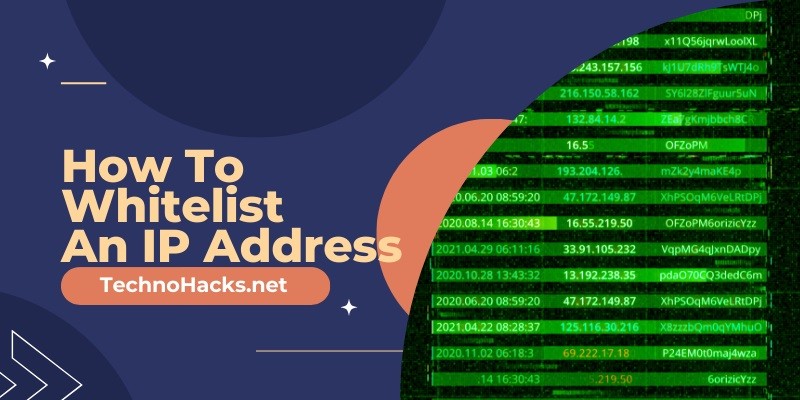How To Whitelist An IP Address?
IP whitelisting is a crucial security measure that can significantly enhance network protection and access control. This article will explore the concept of IP whitelisting, its benefits, implementation steps, best practices, and alternatives.
What is IP Whitelisting?
IP whitelisting, also known as IP allowlisting, is a cybersecurity technique restricting access to networks, systems, or applications to a pre-approved list of IP addresses. It functions like an exclusive guest list for digital resources, where only those with “invitations” (approved IP addresses) are granted entry.
The process works by creating a curated list of trusted IP addresses permitted to access specific digital resources or perform certain actions. When a user attempts to connect, the system checks their IP address against the whitelist. If there’s a match, access is granted; otherwise, it’s denied.
Benefits of IP Whitelisting
Implementing IP whitelisting offers several advantages for organizations:
- Enhanced Security: By limiting access to trusted sources, IP whitelisting significantly reduces the attack surface for potential threats. This additional layer of security is particularly valuable in an era of increasingly sophisticated cyber attacks.
- Control Over Access: IP whitelisting puts administrators in the driver’s seat, allowing them to manage remote teams effectively and control which employees can access different levels of company information.
- Protection Against Unauthorized Users: By default, IP whitelisting blocks all unauthorized access attempts, providing a strong defense against various cyber threats.
- Compliance: For many industries, IP whitelisting can help meet regulatory requirements related to data protection and access control.
Common Scenarios for IP Whitelisting
IP whitelisting is particularly useful in several scenarios:
- Remote Access to Corporate Networks: It can secure connections for remote workers accessing company resources.
- Securing Admin Panels: Administrative interfaces can be protected by allowing access only from specific IP addresses.
- Restricting Access to Sensitive Resources: Critical databases or applications can be safeguarded by limiting access to known IP addresses.
- SaaS User Management: IP whitelisting helps manage cloud risks within the provided access framework for SaaS applications.
- IoT Security: For IoT devices with limited processing power, IP whitelisting can restrict communication channels to trusted entities only.
Steps to Whitelist an IP Address
Identify the IP Address to Whitelist
- How to find your IP address
- Considerations for static vs. dynamic IPs
Access Your Network Security Settings
- Firewall settings
- Router configuration
- Server settings
Add IP to Whitelist
- Step-by-step process
- Variations for different systems (Windows, Linux, etc.)
Verify the Whitelisting
- Testing access
- Troubleshooting common issues
Best Practices for IP Whitelisting
- Regular Review and Maintenance: Periodically review and update your whitelist to ensure it remains current and secure.
- Combined with Other Security Measures: IP whitelisting should be part of a comprehensive security strategy, not a standalone solution.
- Use Static IPs When Possible: Static IP addresses are more reliable for whitelisting as they don’t change over time.
- Implement Proper Access Controls: Ensure that only authorized personnel can modify the whitelist.
- Monitor Access Attempts: Keep logs of both successful and failed access attempts to detect any unusual patterns.
Alternatives to IP Whitelisting
While IP whitelisting can be effective, it’s not always the most practical solution, especially for larger organizations or those with frequently changing network configurations. Here are some alternatives:
- VPN Solutions: Virtual Private Networks provide secure, encrypted connections and can be more flexible than IP whitelisting.
- Multi-Factor Authentication: This adds an extra layer of security beyond just IP addresses.
- Device Authentication: Verifying the specific device attempting to connect can provide more granular control.
- Cloud Access Security Brokers (CASBs): These tools can provide more sophisticated access controls for cloud-based resources.
- Zero Trust Network Access (ZTNA): This model assumes no trust and requires verification from everyone trying to access resources, regardless of their location.
Challenges and Limitations of IP Whitelisting
While IP whitelisting can be a powerful security tool, it’s important to be aware of its limitations:
- Scalability Issues: For larger networks with numerous connections, maintaining an IP whitelist can become cumbersome and time-consuming.
- IP Spoofing: Sophisticated attackers may be able to spoof allowed IP addresses, bypassing the whitelist.
- Dynamic IP Addresses: Many internet connections use dynamic IPs that change periodically, making whitelisting challenging.
- Potential Access Roadblocks: Strict whitelisting can sometimes prevent legitimate users from accessing resources, especially in emergencies.
- Not Foolproof: IP whitelisting alone doesn’t guarantee absolute protection against all forms of attacks.
Conclusion
IP whitelisting is a valuable security measure that can significantly enhance an organization’s cybersecurity posture. By restricting access to trusted IP addresses, it provides an additional layer of protection against unauthorized access and potential cyber threats. However, it’s not without challenges, particularly for larger organizations or those dealing with dynamic IP addresses.

